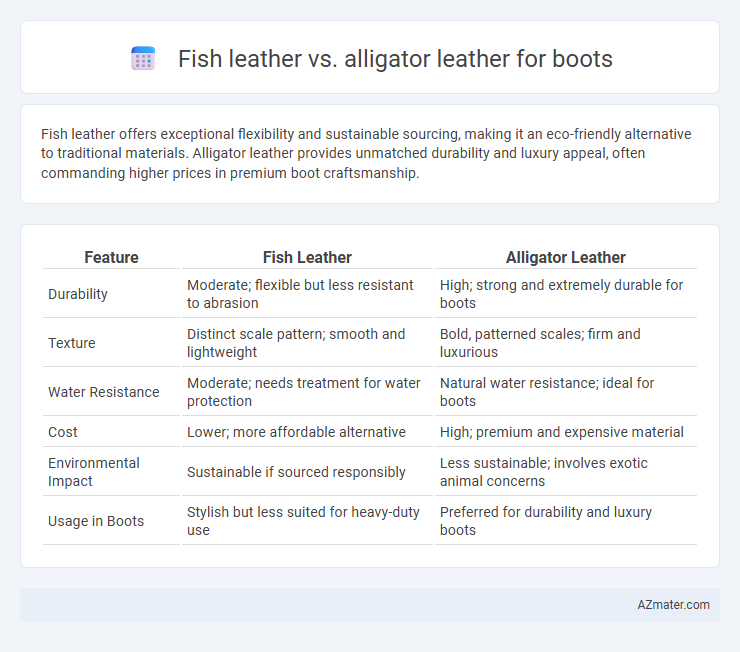Fish leather offers exceptional flexibility and sustainable sourcing, making it an eco-friendly alternative to traditional materials. Alligator leather provides unmatched durability and luxury appeal, often commanding higher prices in premium boot craftsmanship.
Table of Comparison
| Feature | Fish Leather | Alligator Leather |
|---|---|---|
| Durability | Moderate; flexible but less resistant to abrasion | High; strong and extremely durable for boots |
| Texture | Distinct scale pattern; smooth and lightweight | Bold, patterned scales; firm and luxurious |
| Water Resistance | Moderate; needs treatment for water protection | Natural water resistance; ideal for boots |
| Cost | Lower; more affordable alternative | High; premium and expensive material |
| Environmental Impact | Sustainable if sourced responsibly | Less sustainable; involves exotic animal concerns |
| Usage in Boots | Stylish but less suited for heavy-duty use | Preferred for durability and luxury boots |
Overview of Fish Leather and Alligator Leather
Fish leather, derived from species such as salmon and perch, offers a unique texture characterized by tight, uniform scales and exceptional durability suitable for boots. Alligator leather, known for its distinctive, irregular scale patterns and natural strength, commands a higher price due to its rarity and status as a luxury material. Both leathers provide water resistance and flexibility, but fish leather stands out for its eco-friendly tanning processes and lighter weight, making it an innovative choice in high-quality boot manufacturing.
Origins and Sourcing of Each Leather
Fish leather originates primarily from the scales and skins of fish species such as salmon, perch, and cod, often sourced from sustainable fisheries or as byproducts of the seafood industry, emphasizing eco-friendly practices. Alligator leather comes from farmed or wild alligators mainly in the southeastern United States, with a rigorous regulatory framework to ensure sustainability and legal compliance. Both materials reflect unique heritage and sourcing methods, with fish leather highlighting aquatic biodiversity and alligator leather tied to traditional exotic leather markets.
Tanning Processes: Fish vs Alligator Leather
Fish leather tanning involves vegetable or chrome tanning techniques tailored to its fine grain and moisture-rich texture, resulting in a supple yet durable material ideal for boots. Alligator leather undergoes a more intricate tanning process, often using specialized chemicals to preserve its dense, scaly structure and enhance longevity and resistance to wear. The tanning processes for fish leather emphasize flexibility and lightness, whereas alligator tanning prioritizes toughness and the preservation of distinctive scale patterns.
Appearance and Texture Comparison
Fish leather features a unique, fine scale pattern that offers a distinct, textured appearance often described as delicate and intricate, while alligator leather presents a bold, larger scale pattern with a glossy finish that exudes luxury and ruggedness. In terms of texture, fish leather is generally thinner, flexible, and smooth with subtle ridges, making it lightweight and comfortable for boots, whereas alligator leather is thicker, tougher, and more durable, providing substantial structure and a premium feel. The contrasting grain patterns and tactile differences make fish leather ideal for stylish, contemporary boots, and alligator leather preferable for classic, high-end footwear with a strong visual impact.
Durability and Performance in Boots
Fish leather, especially from species like salmon and perch, offers lightweight durability with natural flexibility, making it resistant to stretching and ideal for comfortable boot wear. Alligator leather is renowned for its exceptional toughness and abrasion resistance, providing superior protection and longevity in rugged conditions. Boots crafted from alligator leather typically outperform fish leather in durability, but fish leather's breathability and water resistance contribute to enhanced performance in varied environments.
Environmental Impact and Sustainability
Fish leather offers a lower environmental footprint compared to alligator leather, as it utilizes by-products from the fishing industry that would otherwise be discarded, reducing waste and resource consumption. Alligator leather production often involves intensive farming practices and habitat disruption, contributing to higher ecological strain and water usage. The sustainable advantage of fish leather lies in its biodegradable nature and minimal chemical treatment requirements, promoting eco-friendly footwear options.
Comfort and Wearability Factors
Fish leather offers exceptional breathability and flexibility, making it highly comfortable for boots worn in warmer climates or extended periods. Alligator leather provides superior durability and structure, ideal for maintaining shape and withstanding heavy use, but it can be stiffer and less breathable. Both materials offer unique wearability benefits: fish leather excels in lightweight comfort, while alligator leather delivers long-lasting toughness and support.
Pricing and Market Availability
Fish leather, such as salmon or perch, offers a sustainable and affordable alternative to alligator leather, with prices often significantly lower due to easier sourcing and faster production cycles. Alligator leather commands premium pricing because of its rarity, durability, and luxury status, making it less accessible in the market and typically reserved for high-end boots. Market availability of fish leather is increasing steadily, driven by eco-conscious consumers and designers, while alligator leather remains limited by strict regulations and conservation efforts.
Maintenance and Care Requirements
Fish leather requires gentle cleaning with mild soap and water, avoiding excessive moisture to prevent damage, and benefits from regular conditioning to maintain its flexibility and natural texture. Alligator leather demands more intensive care, including specialized leather conditioners and careful moisture control to preserve its distinctive scales and prevent cracking. Proper storage away from direct sunlight and humidity is essential for both types to ensure durability and longevity in boots.
Final Verdict: Choosing the Best Leather for Boots
When choosing the best leather for boots, fish leather offers exceptional durability and a unique, textured aesthetic, ideal for fashion-forward wearers seeking sustainability. Alligator leather provides unmatched luxury, softness, and a distinctive pattern, perfect for premium, high-end boots with a classic appeal. The final verdict depends on whether the priority lies in eco-friendly innovation and affordability or timeless elegance and exclusivity in boot design.

Infographic: Fish leather vs Alligator leather for Boot
 azmater.com
azmater.com